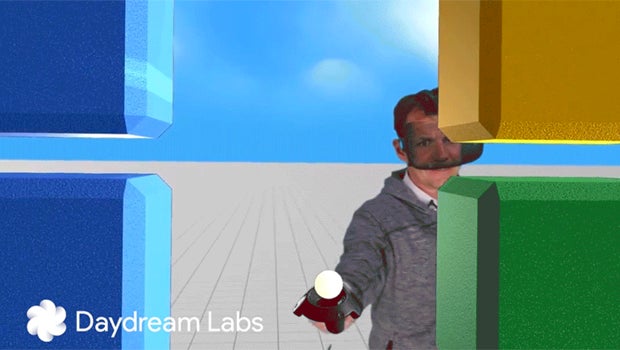New Google tech shows how you really look inside a VR headset

One of the inherent limitations of owning a VR headset is that only one person can use it at a time.
However, on the flip side there’s also a lot of fun to be had sitting in a group and watching the reactions of friends and family as they navigate through the virtual world.
Even then though, you’re limited to physical reactions and whatever the wearer’s mouth is doing.
Google is hoping to enhance those experiences, thanks to new digital tech that makes headsets transparent and enabling others to see the wearer’s full face.
“Headsets can get in the way,” writes Google research engineer Avneesh Sud.
“If you’re watching someone else use VR, it’s hard to tell what’s going on and what they’re seeing. And if you’re in VR with someone else, there aren’t easy ways to see their facial expressions without an avatar representation.”
Related: Google Daydream VR review
The Daydream Labs and Google Research teams have been using machine learning, 3D computer vision and what it calls ‘advanced rendering techniques’ that effectively remove the headsets and show the wearer’s expressions in mixed reality.
“With this new technology, we’re able to make a more complete picture of the person in VR,” Sud writes on the Google blog.
“This model allows us to mimic where the person is looking, even though it’s hidden under the headset.”
https://twitter.com/statuses/834206800840843264
However, it’s not like this technology is going to be ready for prime time any time soon.
It requires a green screen, video camera, super accurate eye tracking from inside the headset and the need to create a 3D model of the person’s face. Also, it should be noted, Google used a HTC Vive rather than its own Daydream VR headset.
The final step is to add the person into the virtual world, enabling viewers to see the person more-or-less naturally within that VR environment.
“Seeing beyond VR headsets could help enhance communication and social interaction in VR. Imagine being able to VR video conference and see the expressions and nonverbal cues of the people you are talking to, or seeing your friend’s reactions as you play your favorite game together,” Sud says.
Is the ability to see yourself and your friends within the environment the next big leap for VR? Drop us a line in the comments below.


